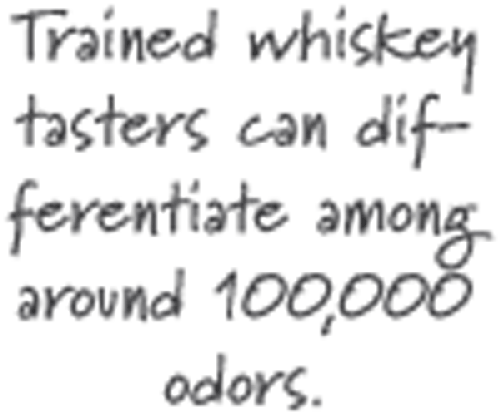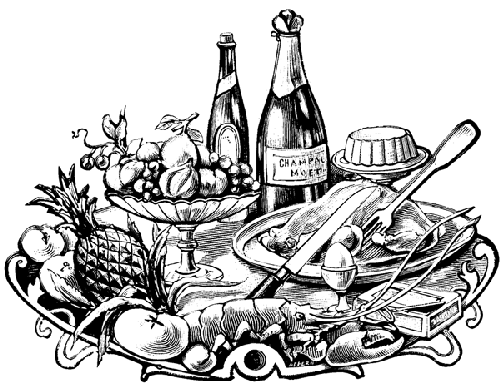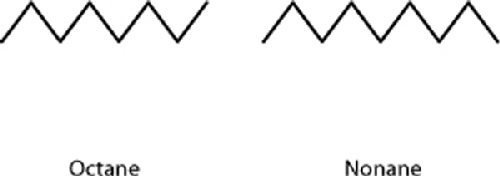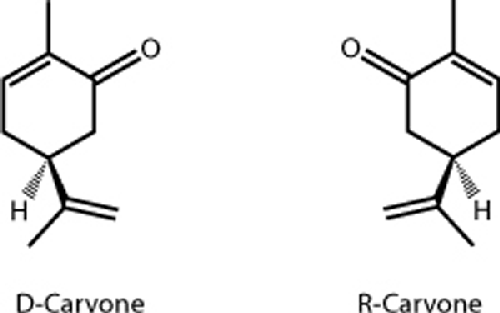2. Smell (Olfactory Sense)While the sensation of taste is limited to a few basic (and important) sensations,
smell is a cornucopia of data. We’re wired to detect somewhere around 1,000 distinct
compounds and are able to discern somewhere over 10,000 odors. Like taste, our sense of
smell (olfaction) is based on sensory cells
(chemoreceptors) being “turned on” by chemical compounds. In smell,
these compounds are called odorants. In the case of olfaction, the receptor cells are located in the olfactory epithelium
in the nasal cavity and respond to volatile chemicals—that is, compounds that evaporate
and can be suspended in air such that they pass through the nasal cavity where the
chemoreceptors have a chance to detect them. Our sense of smell is much more acute than
our sense of taste; for some compounds, our nose can detect odorants on the order of one
part per trillion. There are a few different theories as to how the chemoreceptors responsible for
detecting smell work, from the appealingly simple (“the receptors feel out the shape of
the odor molecule”) to more complex chemical models. The more recent models suggest that
an odorant can bind to a number of different types of chemoreceptors and a chemoreceptor
can accept a number of different types of odorants. That is, any given odor triggers a
number of different receptors, and your brain applies something akin to a fuzzy
pattern-matching algorithm to recall the closest prior memory. Regardless of the details,
the common theme of the various models suggests that we smell based on some set of
attributes such as the shape, size, and configuration of the odor molecules. 
This
more complex model—in which a single odorant needs to be picked up by multiple
receptors—also suggests an explanation for why some items smell odd when you receive only
a weak, partial whiff. To use a music analogy, it’s like not hearing the entire set of
notes that make up a chord: our brains can’t correctly match the sensation and might find
a different prior memory closer to the partial “chord” and misidentify the smell.
Note: It also appears that we smell in stereo: just as our ears hear separately, we use
our left and right nostrils independently. Researchers at UC Berkeley have found that
with one nostril plugged up, we have a much harder time tracking scents, due to lack of
“inter-nostril communication.”
While you might think of smell as being only what you sense when leaning forward and
using your nose to take a whiff of a rose, that’s only half the picture. Odors also travel
from food in your mouth into the nasal cavity through the shared airway passage: you’re
smelling the food that you’re “tasting.” When cooking, keep in mind that you can smell only volatile compounds in a dish. You
can make nonvolatile compounds volatile by adding alcohol (e.g., wine in sauces), which
raises the vapor pressure and lowers the surface tension of the compounds, making it that
much more likely that they will evaporate and pass by your chemoreceptors.
Note: Chemists call this cosolvency. In this case, the ethanol
molecule takes the place of the water molecules normally attached to the compounds,
resulting in a lighter molecule, which then has a higher chance of evaporating.
Here’s a simple experiment that shows the difference between taste and smell. You’ll
need a test subject, two spoons, a grater, an apple, and a potato. Without the subject
seeing, grate some of the apple (without skin) onto one spoon, and grate some of the
potato (again, without skin) onto the other spoon. Have the subject pinch her nose shut,
and give her both spoons to taste. Make sure she keeps that nose pinched the entire
time! This prevents the air carrying the odorants from circulating up into the nasal
cavity. After she’s tried both spoons, instruct her to stop pinching her nose, and note
what sensations occur. If you want to do this with a large group, flavored jelly beans
work, too. |
Temperature also plays an important role in olfaction. We have a harder time smelling
cold foods because temperature partially determines a substance’s volatility. Your sense of taste is affected by temperature, too. Researchers have found that the
intensity of primary tastes varies with the temperature both of the food itself and of the
tongue. The ideal temperature is 95°F / 35°C, the approximate temperature of the top of
the tongue. Colder foods result in tastes having lower perceived strength, especially for
sugars. It’s been suggested that red wines are best served at room temperature to help
convey their odors, while white wines are better served chilled
to moderate the levels of volatile compounds and sweetness. This would make sense—by
chilling white wine, it’ll be less likely to overpower the milder meals that they
customarily accompany, such as fish.
Jim Clarke is a wine writer whose work has appeared in the New
York Times, the San Francisco Chronicle, Imbibe,
and Foreign Policy, as well as on Forbes.com and
StarChefs.com. He is also the wine director at Megu in New York City. Above, Jim
stands in front of wood-fired brewing kettles at the Brasserie Caracole in
Belgium. How do you pair beverages with food? What you’re looking for is the structure of the beverage and the dish. For example,
if you have sweetness in a dish, you’re going to want a similar level of sweetness in
the wine. If you don’t, the wine will taste relatively flat compared to the dish, or if
the wine is too sweet, the dish will be less expressive. Another example would be acidity. Salads can be very difficult because you have
acidities in the vinaigrette dressing, so you need a wine that is going to have that
acidity as well, or the wine is going to seem flat or even a little bit bitter next to
the dressing. If you want high acidity, you can buy an Austrian Grüner Veltliner, a New
Zealand Sauvignon Blanc, a New York Dry Riesling, as a couple of examples. Sancerre are
99% of the time going to be dry and acidic. If you’re not into learning about different wines in and of themselves, then when
you’re buying the wine you should have a retailer who you can talk to. Tell them what
the protein is as well as the sauce or preparation. You want to say, “Grouper with a red
wine sauce as a reduction: should I do that with a red wine or a white wine?” If you
know the dish well and you say, “There’s a really buttery sauce,” then your retailer
will probably direct you to a California Chardonnay. The convention I’m familiar with is to look at the type of
wine. It sounds like this is not a bad approach? It’s not, especially when you talk about Old World wines. A lot of times Old World
wine drinkers wouldn’t differentiate. They would say, “I’m making coq au
vin, so I need a burgundy.” There are good ones and there are bad ones, but
as far as a pairing goes that’s a good pairing. So it can be fairly generic. There is
really a broad range of wines within a given category that are going to work pretty well
with any given dish. What are the key variables in wine
pairings? Acidity, tannins if you’re going with a red wine, body or alcohol level, and
sweetness are really the four main things. Flavor is kind of a bonus. The aromas aren’t
so important to the pairing as the other elements. High alcohol, say California
Chardonnay, can be pretty overwhelming for a delicate fish dish. On the other hand, with
lobster it’s often fantastic because of lobster’s rich flavor. Look where a wine comes from; that really tells you quite a bit. In 95% of cases, if
it’s somewhere warm, the wine probably has fuller body. If it’s fuller-bodied, then it
has lower acidity, because those two have an inverse relationship. Sugar in the grapes
eventually becomes alcohol in the wine. Unripe fruit is tart; that’s acidity. As it
becomes ripe, it comes into balance. If it’s overripe, it actually tastes kind of plain
because the acidity has dropped out. Take a place like California, where there are these
beautiful warm vintages. Ask me for a light-bodied California white and I’ve really got
to dig on my list. There are a few little isolated areas that do it, but it’s really not
what they do best. On the other hand, Austrian whites are generally from a cool-climate
growing area; those are usually pretty good in acidity, light to medium bodied, and
lower alcohol. Why do so many people talk about
flavor and aroma instead? People find it much more poetic to talk about the aromas and the flavors. From a
practical point of view, if I’m a sommelier on the floor, I’ll be very careful about
using the word “acidity” with guests. I’ll use all sorts of euphemisms like “crisp” or
“fresh,” because people don’t think about acidity in the context of food. “I don’t want
to drink acid! That sounds terrible!” The fact of the matter is that every beverage has
acid in some balance with sugar. Coca Cola technically has more acid than any wine you
can think of. It seems like the way that somebody inside the industry
talks about wine is not the same language that’s used publicly. Why is
that? If I’m talking to someone in the industry and they say a modern Rioja, I know
exactly what they mean, so we skip a lot of stuff. When I’m training servers or people
new to the restaurant industry who need to learn about wine, I talk about that cold
climate/hot climate thing and then—and this is a little bit harder, because wine making
is changing—about Old World versus New World. New World has more fruit expression; Old
World has more earth and spice sort of things. It’s still generally true, but there are
always exceptions. If someone tells me it’s a classic Napa Cab, I know it’s full bodied
because of the warm climate and has more fruit expression because it’s New World. So
when we talk, we only have to say how it’s different from that model, whereas when I
talk to the consumer, I can’t assume that they have that understanding already. Are there similar kinds of variables that you use to
describe beer pairings? Alcohol is still a factor, as is sweetness—acidity not so much except in some
unusual beers like lambics. You don’t have tannins but you have hops. Those play into
how you pair, just like acidity and those other things in wine. One of my favorite
classics is oysters and dry stout. Are there particular things that you would avoid in
pairings? Don’t go overboard trying to get the right pairing, especially if you have a style
of wine or beer that you really don’t like. People will say, “I’m trying to eat fish
because it’s healthier, but I love red wine.” Well, don’t let that stop you. I drink all
sorts of wine depending on the occasion or how I feel, but if I’m not in the mood for a
big red and I’m having a steak, I’ll find something else. You need to match with your
own tastes along with matching the food. Certainly, as a sommelier, the first thing I’m
trying to find out is not what the guest is having, but what they like. Pairing is to
give you more pleasure. Any tips for a consumer speaking with a
sommelier? Well, certainly telling sommeliers what you like. Also, a lot of people feel like
they need to dance around price. There is an easy way to do this if you’re entertaining
guests and you don’t want to make a big show of not spending a lot of money. When I’m
talking to a guest I will have the list open right there so they can run their finger
along the name of the wine to the price. They tell me what they’re interested in
spending. If you wanted to say, “We’re looking for something around $100,” that’s fine,
too, but this is kind of a genteel way of doing it. This will save a lot of the feeling
like we’re sparring with each other because now I know what you’re looking for, both in
style and in price range, and we’ll find a wine for you. Is there an exercise that one could do to better understand
how to do wine pairings? Get four glasses, one with lemon juice and water, one with very overbrewed ice tea,
one with some sugar dissolved in water, and one with half vodka, half water. Then get a
few dishes or ingredients and taste each of them with the different elements—tasting
with lemon juice, the sugar water, the tannins in the tea, and then alcohol. You can see
what each individual element is doing to, say, a piece of cheese. What is each doing to
this piece of asparagus? You’ll see what those different elements are and how they
affect the food. We’re not talking about wine flavors at all, just the four elements
that occur in wine that are really important to the pairing process. 
|
Our noses are veritable chemical detectors on par with
modern lab equipment. Our sense of smell is capable of distinguishing the difference a
single carbon atom makes (e.g., octane versus nonane) and sniffing out compounds all the
way down to the level of 0.00002 parts per billion (for one compound in grapefruit).
That said, factors such as age, hormonal levels, and exposure mean that some of us
notice smells at lower thresholds than others. 
Not all compounds can be smelled. Size, shape, and something called chirality all
determine whether a molecule is smellable or not. Chirality has to
do with whether or not a molecule and its mirror version (the pair is known as
enantiomers) are identical. Your left and right hands, for
instance, are chiral because they are not identical, even though they have the same
fundamental shape. Carvone is a classic example in chemistry: the compound D-carvone
smells of caraway, while R-carvone smells of spearmint. 
Some chemical structures have distinct smells, and the families of compounds that
contain those structures generally end up smelling similar. Esters (compounds with the
general formula of R-CO-OR’) are classically thought of as having fruity aromas. Amines
smell stinky and rotting, like week-old raw fish, with cadaverine and putrescine being
two of the more well-known odors. And aldehydes (organic compounds that have a carbon
atom both double-bonded to an oxygen atom and bonded to a hydrogen atom) tend to smell
green or plant-like. While smelling an aldehyde won’t bring the entire smell of, say, green ivy, it’s
similar enough that industry can use aldehyes as artificial odorants to trick our brains
into thinking we’re smelling the real thing. Artificial flavorings are used in products
from laundry detergent to candies, because they cost less and in some cases are
chemically more stable than the original scents. Artificial vanilla extract, for
example, generally contains just vanillin, which has the molecular formula
C8H8O3, which
happens to be the most common chemical in vanilla. Although the artificial stuff is
missing all the other compounds from vanilla, we still find it to be enjoyable. Many other herbs and spices are also composed of just a few key chemicals, making
artificial extracts of them relatively close to the real thing. Fruits, however, have
hundreds of compounds that are involved in creating their aromas. Even adding the dozen
or so most common chemicals for an artificial strawberry flavoring, for example, leaves
200+ volatile compounds missing in the “odor spectrum.” This is why artificial fruit
flavors tend to taste, well, artificial (chocolate, too). 
Here are a few examples of
compounds and their smells. A number of these compounds can be purchased online if you
happen to have an account with an industrial supplier, such as sigma.com.
(Make sure you acquire food or medical grade versions!) Flavored jelly beans
and scratch-and-sniff stickers are just a few products that rely on these compounds,
so if you don’t just happen to have an account with an industrial supplier, try
popping open a package of jelly beans and seeing if you can identify some of the odors
with these compounds.
2,4-dithiapentane: Black truffle Black truffle oils commonly use this in lieu of oil from real truffles.
Isoamyl acetate: Banana Creating artificial banana extract is one of the classic chem lab projects, to
the annoyance of teachers in adjoining rooms. It’s also the pheromone that honey
bees use to signal attacking, so don’t take overly ripe bananas on a picnic during
the height of bee season.
Benzaldehyde: Almond Primary component of bitter almond oil.
Diacetyl: Like butter Used in microwave popcorn and Jelly Belly’s “Buttered Popcorn” flavor, in
large doses it causes a lung disease called “popcorn lung.”
Furaneol: Strawberry Also occurs in pineapple, tomatoes, and buckwheat.
Hexanal: Generic fruity flavor, “tutti frutti” (like pink bubble gum) Search Sigma.com for 115606-2ml. Used in Jelly Belly’s “Tutti Frutti”
flavor.
Hexyl acetate: Golden Delicious apple Search Sigma.com for 25539-1ml.
Maple lactone: Like maple syrup Search Sigma.com for 178500-10g.
1-p-menthene-8-thiol and nootkatone: Grapefruit Grapefruit has at least 126 volatile compounds, but these two seem to be the
primary ones. Jelly Belly’s “Grapefruit” flavor likely includes this
compound.
|
Then there’s the effect of the temperature of the tongue itself. For example, when
drinking a cold soda, as you consume more and more of it, your tongue will begin to cool
down. And as your tongue cools, you should perceive the soda as being less sweet. There’s
a reason why warm soda is gross: it tastes sweeter, cloyingly so, than when it’s cold.
What does all this mean when you’re in the kitchen? Keep the impact of temperature on your
senses of smell and taste in mind when making dishes that will be served cold. You’ll find
the frozen versions of things like ice cream and sorbet to be weaker tasting and smelling
than their warmer, liquid versions, so adjust the mixtures accordingly. As an example, try making the following pear sorbet. Note the difference in sweetness
between the warm liquid and the final sorbet. Yes, you could just buy a container of
sorbet and let some of it melt, but where’s the fun in that?
|